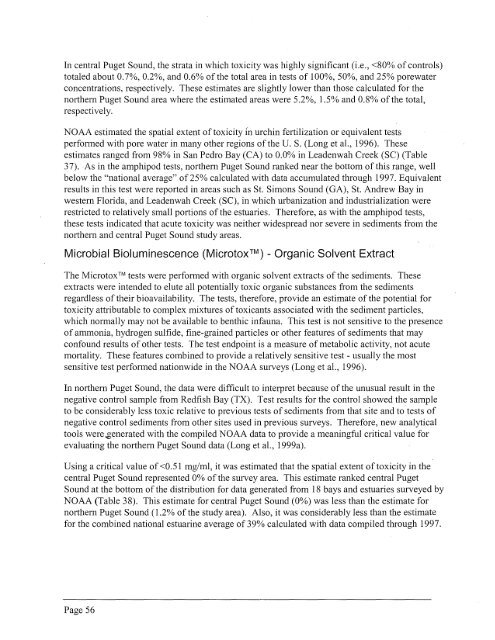Sediment Quality in Puget Sound Year 2 - Center for Coastal ...
Sediment Quality in Puget Sound Year 2 - Center for Coastal ...
Sediment Quality in Puget Sound Year 2 - Center for Coastal ...
You also want an ePaper? Increase the reach of your titles
YUMPU automatically turns print PDFs into web optimized ePapers that Google loves.
hi central <strong>Puget</strong> <strong>Sound</strong>, the strata <strong>in</strong> which toxicity was highly significant (i.e., 4 0% of controls)<br />
totaled about 0.7%, 0.2%, and 0.6% of the total area <strong>in</strong> tests of loo%, 50%, and 25% porewater<br />
concentrations, respectively. These estimates are slightly lower than those calculated <strong>for</strong> the<br />
northern <strong>Puget</strong> <strong>Sound</strong> area where the estimated areas were 5.2%, 1.5% and 0.8% of the total,<br />
respectively.<br />
NOAA estimated the spatial extent of toxicity <strong>in</strong> urch<strong>in</strong> fertilization or equivalent tests<br />
per<strong>for</strong>med with pore water <strong>in</strong> many other regions of the U. S. (Long et al., 1996). These<br />
estimates ranged from 98% <strong>in</strong> San Pedro Bay (CA) to 0.0% <strong>in</strong> Leadenwah Creek (SC) (Table<br />
37). As <strong>in</strong> the amphipod tests, northern <strong>Puget</strong> <strong>Sound</strong> ranked near the bottom of this range, well<br />
below the "national average" of 25% calculated with data accumulated through 1997. Equivalent<br />
results <strong>in</strong> this test were reported <strong>in</strong> areas such as St. Simons <strong>Sound</strong> (GA), St. Andrew Bay <strong>in</strong><br />
western Florida, and Leadenwah Creek (SC), <strong>in</strong> which urbanization and <strong>in</strong>dustrialization were<br />
restricted to relatively small portions of the estuaries. There<strong>for</strong>e, as with the amphipod tests,<br />
these tests <strong>in</strong>dicated that acute toxicity was neither widespread nor severe <strong>in</strong> sediments from the<br />
northern and central <strong>Puget</strong> <strong>Sound</strong> study areas.<br />
Microbial Biolum<strong>in</strong>escence (MicrotoxTM) - Organic Solvent Extract<br />
The MicrotoxTM tests were per<strong>for</strong>med with organic solvent extracts of the sediments. These<br />
extracts were <strong>in</strong>tended to elute all potentially toxic organic substances from the sediments<br />
regardless of their bioavailability. The tests, there<strong>for</strong>e, provide an estimate of the potential <strong>for</strong><br />
toxicity attributable to complex mixtures of toxicants associated with the sediment particles,<br />
which normally may not be available to benthic <strong>in</strong>fauna. This test is not sensitive to the presence<br />
of ammonia, hydrogen sulfide, f<strong>in</strong>e-gra<strong>in</strong>ed particles or other features of sediments that may<br />
confound results of other tests. The test endpo<strong>in</strong>t is a measure of metabolic activity, not acute<br />
mortality. These features comb<strong>in</strong>ed to provide a relatively sensitive test - usually the most<br />
sensitive test per<strong>for</strong>med nationwide <strong>in</strong> the NOAA surveys (Long et al., 1996).<br />
In northern <strong>Puget</strong> <strong>Sound</strong>, the data were difficult to <strong>in</strong>terpret because of the unusual result <strong>in</strong> the<br />
negative control sample from Redfish Bay (TX). Test results <strong>for</strong> the control showed the sample<br />
to be considerably less toxic relative to previous tests of sediments from that site and to tests of<br />
negative control sediments from other sites used <strong>in</strong> previous surveys. There<strong>for</strong>e, new analytical<br />
tools weregenerated with the compiled NOAA data to provide a mean<strong>in</strong>gful critical value <strong>for</strong><br />
evaluat<strong>in</strong>g the northern <strong>Puget</strong> <strong>Sound</strong> data (Long et al., 1999a).<br />
Us<strong>in</strong>g a critical value of







